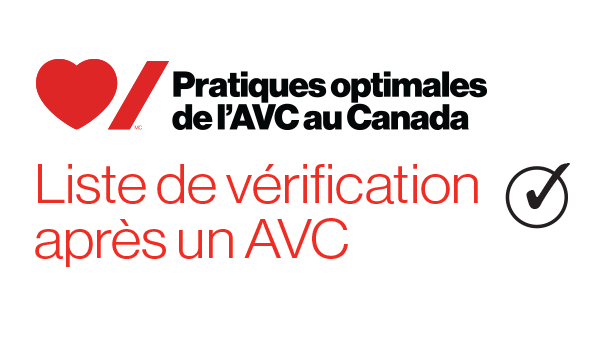- Définition et considérations
- 1. Évaluation initiale des besoins en matière de réadaptation post-AVC
- 2. Soins offerts dans les unités de réadaptation post-AVC
- 3. Prestation des soins de réadaptation post-AVC en milieu hospitalier
- 4. Réadaptation à domicile et en consultation externe post-AVC (y compris le congé précoce assisté)
- 5.1 Prise en charge des membres supérieurs après un AVC : principes généraux et traitements
- 5.2 Amplitude du mouvement et spasticité de l’épaule, du bras et de la main
- 5.3 Prise en charge de la douleur à l’épaule et du syndrome douloureux régional complexe (SDRC) après un AVC
- 6.1 Équilibre et mobilité
- 6.2 Spasticité des membres inférieurs après un AVC
- 6.3 Prévention et prise en charge des chutes
- 7. Évaluation et prise en charge de la dysphagie et de la malnutrition après un AVC
- 8. Réadaptation en cas de troubles de la perception visuelle
- 9. Prise en charge de la douleur centralisée
- 10. Réadaptation en vue d’améliorer la capacité à parler et à communiquer
- 11. Téléréadaptation après un AVC
7. Évaluation et prise en charge de la dysphagie et de la malnutrition après un AVC
6ème édition - 2019 MISE À JOUR
7.1 Dysphagie
- Avant toute prise orale (p. ex., médicaments, aliments, liquides), les patients devraient faire l’objet d’une évaluation des troubles de la déglutition effectuée au moyen d’un outil de dépistage valide par un professionnel ayant reçu la formation appropriée [niveau de preuve B]. Voir l’annexe 2, tableau 3 : Outils de dépistage et d’évaluation recommandés pour la dysphagie pour de plus amples renseignements.
- En cas de résultats anormaux du dépistage initial ou continu des troubles de déglutition, les patients doivent être dirigés, le cas échéant, à un orthophoniste, un ergothérapeute, un diététiste ou d’autres cliniciens spécialisés en dysphagie, pour une évaluation approfondie et une prise en charge à leur chevet de la déglutition, de l’alimentation et de l’état nutritionnel et d’hydratation [niveau de preuve C].
- Un plan de prise en charge personnalisé doit être élaboré pour tenir compte du traitement de la dysphagie, des besoins alimentaires et des plans de nutrition particulière [niveau de preuve C].
- Une évaluation de la déglutition par radioscopie télévisée ou par fibroscopie doit être effectuée chez tous les patients considérés comme étant à risque élevé de dysphagie oropharyngée ou de mauvaise protection des voies respiratoires, selon les résultats de l’évaluation au chevet, afin d’orienter la prise en charge de la dysphagie (p. ex., le traitement) [niveau de preuve B].
- Selon les résultats de la radioscopie télévisée ou de la fibroscopie, un traitement visant à améliorer les capacités de déglutition ou des techniques compensatoires visant à améliorer l’efficacité et la sécurité du mécanisme de déglutition à la phase oropharyngée devraient être mis en œuvre en plus d’être suivis et réévalués au besoin [niveau de preuve B].
- Les exercices pouvant être utilisés dans le cadre de la thérapie visant à rétablir la déglutition incluent des exercices de résistance pour la langue, de rétention du souffle et de déglutition volontaire [niveau de preuve B].
- Les techniques compensatoires pouvant être utilisées incluent des exercices de posture, le rapport sensoriel avec un bolus, la maîtrise volitive et le changement de texture [niveau de preuve B].
- Les patients, les familles et les aidants doivent recevoir de l’information sur la déglutition et la prévention de l’aspiration ainsi que des recommandations alimentaires [niveau de preuve C].
- Afin de réduire le risque de pneumonie, il faudrait non seulement permettre que les patients se nourrissent eux-mêmes autant que possible, mais aussi les encourager à le faire [niveau de preuve C].
- Les soins buccodentaires devraient être méticuleux et les patients devraient être bien renseignés sur l’importance de maintenir une bonne hygiène buccodentaire afin de réduire davantage le risque de pneumonie [niveau de preuve B].
7.2 Nutrition et hydratation
- Les patients devraient faire l’objet d’un dépistage de la malnutrition au moyen d’un outil de dépistage valide, et ce, idéalement dans les 48 heures suivant leur admission en réadaptation en milieu hospitalier [niveau de preuve C]. Voir l’annexe 2, au tableau 3 : Outils de dépistage et d’évaluation recommandés pour la dysphagie pour de plus amples renseignements.
- L’évaluation de l’état nutritionnel du patient doit être répétée périodiquement, tout au long de l’hospitalisation et avant la sortie ainsi qu’en consultation externe et en milieu communautaire [niveau de preuve C].
- Les résultats de cette évaluation peuvent servir à prendre la décision d’orienter le patient vers un nutritionniste en vue d’un examen approfondi et d’une prise en charge suivie de l’état nutritionnel et d’hydratation [niveau de preuve C].
- Les patients ayant subi un AVC que l’on soupçonne d’avoir des problèmes de nutrition, d’hydratation, de dysphagie ou d’autres troubles concomitants qui pourraient nécessiter une intervention nutritionnelle devraient être dirigés vers un diététiste [niveau de preuve B]. Les diététistes fournissent des recommandations sur les éléments suivants :
- La façon de satisfaire les besoins en nutriments et en liquides par voie orale, tout en envisageant les modifications en matière de texture des aliments et de consistance des liquides recommandées par un diététiste, orthophoniste ou un autre professionnel ayant suivi une formation appropriée, comme il se doit [niveau de preuve B].
- L’alimentation entérale pour les patients incapables d’avaler ou de satisfaire leurs besoins en nutriments et liquides par voie orale [niveau de preuve B].
- Si le patient a besoin d’alimentation entérale pour une période prolongée, la sonde nasogastrique devrait être remplacée par une sonde gastrojéjunale [niveau de preuve B].
- La décision de procéder à l’alimentation entérale, c’est-à-dire au moyen d’une sonde, devrait être prise le plus tôt possible après l’admission, habituellement dans les trois premiers jours, en collaboration avec le patient, sa famille (ou le mandataire spécial) et l’équipe interdisciplinaire [niveau de preuve B].
Les estimations publiées de l’incidence de la dysphagie associée à l’AVC fluctuent entre 19 % et 65 % dans la phase aiguë, en fonction du site de la lésion, du temps écoulé et du choix de la technique d’évaluation. La dysphagie est cliniquement importante parce qu’elle est associée à des taux de mortalité et de complications plus élevés, notamment de pneumonie. Le risque de pneumonie est considéré comme étant trois fois plus grand en présence de dysphagie. La pneumonie liée à l’AVC est assez fréquente, avec des estimations d’incidences allant de 5 à 26 %, selon les critères diagnostiques. Les patients souffrant de dysphagie reçoivent souvent un apport calorique insuffisant, et la malnutrition peut entraîner des résultats plus faibles.
Les personnes ayant subi un AVC soulignent l’importance de l’instruction et de la formation des aidants en ce qui concerne les risques potentiels de dysphasie, comme l’aspiration.
Pour une bonne prise en charge de la dysphagie et de la malnutrition post-AVC, les organismes doivent:
- Élaborer et offrir des programmes éducatifs pour former les membres du personnel concernés au dépistage initial des problèmes de déglutition chez les patients ayant subi un AVC. Il peut s’agir d’employés de tous les secteurs du continuum, comme les services d’urgence, les unités d’hospitalisation de soins de courte durée, les établissements de réadaptation et les établissements de soins communautaires et de longue durée.
- Assurer l’accès à des professionnels de la santé ayant reçu une formation appropriée, notamment des orthophonistes, des ergothérapeutes et des nutritionnistes, qui peuvent effectuer des évaluations approfondies et recommander des mesures de prise en charge appropriées pour la prévention de la malnutrition et de l’aspiration.
- Proportion de patients ayant subi un AVC pour qui une évaluation initiale de dépistage de la dysphagie a été documentée à l’urgence ou à l’admission à l’hôpital (prioritaire).
- Proportion des patients ayant subi un AVC qui ont échoué à l’examen initial de la dysphagie et qui ont ensuite été évalués par un orthophoniste, un ergothérapeute, un nutritionniste ou un autre professionnel de la santé ayant reçu une formation appropriée.
- Délai médian en minutes entre l’arrivée du patient à l’urgence et le dépistage initial de la dysphagie par un clinicien qui a reçu une formation à cet effet.
- Incidence de la malnutrition sur les patients admis à l’hôpital en raison d’un AVC entraînant un délai avant la sortie de l’hôpital.
Notes relatives à la mesure des indicateurs
- Le dépistage de la dysphagie est souvent mal documenté au dossier médical du patient. Les cliniciens devraient être bien renseignés sur l’importance de le documenter pour assurer une mesure et un suivi valides et fiables.
- L’indicateur de rendement 1 est un élément à rapporter de manière obligatoire en vue du programme Distinction – Services aux victimes d’AVC d’Agrément Canada.
Renseignements destinés aux fournisseurs de soins de santé
- Tableau 1 : Outils de dépistage et d’évaluation pour la réadaptation post-AVC (en anglais)
- Tableau 3 : Outils de dépistage et d’évaluation recommandés pour la dysphagie (en anglais)
- Mini Nutritional Assessment (évaluation nutritionnelle)
- Malnutrition Universal Screening Tool (MUST) [outil universel de dépistage de la malnutrition]
- Outil canadien de dépistage nutritionnel
- Info AVC
Informations destinées aux personnes ayant subi un AVC, à leur famille et à leurs aidants
- Prendre en main son rétablissement : fiche d’information sur la réadaptation et le rétablissement
- Prendre en main son rétablissement : fiche d’information sur les transitions et la participation communautaire
- Aphasia Institute (en anglais seulement)
- Liste de contrôle post-AVC
- Le répertoire des services et ressources de Cœur + AVC
- Votre cheminement après un accident vasculaire cérébral : un guide à l’intention des survivants de l’AVC
- Des renseignements sur la difficulté à avaler
- Info AVC
Lien vers les tableaux de données probantes et la liste des références (en Anglais)
The use of a standardized program for bedside screening is now included in most clinical guidelines. Its implementation has long been thought to decrease the incidence of dysphagia-related pneumonia. Bedside screening may include components related to a patient’s level of consciousness, an evaluation of the patient’s oral motor function and oral sensation, as well as the presence of a cough. It may also include trials of small sips of water, whereby a “wet” or hoarse voice are suggestive of an abnormal swallow. A recent systematic review (Smith et al. 2018) included the results from 3 RCTs comparing dysphagia screening protocols or quality improvement interventions designed to improve screening rates versus no screening, alternative screening, usual care. The percentage of patients who received dysphagia screening and developed pneumonia was not significantly lower, compared with patients in a control group, in any of the trials. The authors highlight the lack of evidence from RCTs and state that “no conclusions can be drawn about the clinical effectiveness of dysphagia screening protocols.”
While texture-modified diets, the use of restorative swallowing therapy, and compensatory techniques, are the most commonly used treatments for the management of dysphagia in patients who are still safe to continue oral intake, there is little direct evidence of their benefit. The effectiveness of a variety of treatments for dysphagia and nutritional management was evaluated in a Cochrane review (Bath et al. 2018). Dysphagia treatments examined included acupuncture, behavioural interventions, drug therapy, neuromuscular electrical stimulation, pharyngeal electrical stimulation, physical stimulation (thermal, tactile), transcranial direct current stimulation, and transcranial magnetic stimulation. Overall, there was no reduction in the odds of death or disability or case fatality at the end of the trial associated with dysphagia therapies. While swallowing therapy significantly reduced the proportion of participants with dysphagia at the end of the trial, reduced the risk of chest infections or pneumonia, and was associated with a mean reduction in hospital length of stay or almost 3 days, the authors cautioned that further high-quality trials are required before clinical decisions can be made about what treatments are effective. Neuromuscular electrical stimulation using devices such as VitalStim have been shown to be an effective intervention for restoring swallowing function in trials including persons with stroke-associated dysphagia (Park et al. 2016, Terre & Mearin 2015). While this treatment is popular in the United States and other countries, it is not widely used in Canada. Carnaby-Mann & Crary et al. (2007) conducted a systematic review, which included the results from 7 studies of patients with oropharyngeal dysphagia secondary to stroke, cancer or other disease. A medium-sized treatment effect was reported for the outcome of change in swallowing score (SMD=0.66, 95% CI 0.47 to 0.85, p<0.001). Pharyngeal electrical stimulation is a novel new treatment that is not used routinely in clinical practice. While demonstrated to be safe, its effectiveness remains unproven (Bath et al. 2016).
For patients who cannot obtain nutrient and fluid needs orally, enteral nutrition may be required. Results from the largest trial of its kind indicates that there is little difference between routes of feeding when choosing between enteral feeding approaches. The FOOD trial (Dennis et al. 2005) also addressed the issues of timing of initiation of enteral feeding. The FOOD trial included 1,210 patients admitted within 7 days of stroke from 47 hospitals in 11 countries. In one arm of the trial, patients were randomized to receive either a percutaneous endoscopic gastrostomy (PEG) or nasogastric (NG) feeding tube within 3 days of enrolment into the study. PEG feeding was associated with a non-significant absolute increase in risk of death of 1.0% (–10.0 to 11.9, p=0.9) and a borderline increased risk of death or poor outcome of 7.8% (0.0 to 15.5, p=0.05) at 6 months. In the second part of the trial patients were randomized to receive feeds as early as possible or to avoid feeding for 7 days. Early tube feeding was associated with non-significant absolute reductions in the risk of death or poor outcome (1.2%, 95% CI -4.2 to 6.6, p=0.7) and death (15.8%, 95% CI -0.8 to 12.5, p=0.09) at 6 months. A Cochrane review (Gomes et al. 2015) comparing NG and PED feeding tubes also reported few differences between feeding tube types. PEG tubes were associated with significantly reduced odds of treatment failures (blocked tubes or disruptions in feeding schedule), but there was no significant difference between groups in in mortality, aspiration-related pneumonia or adverse events.
Oral supplementation can be used for patients who are not able to consume sufficient energy and protein to maintain body weight, or for those with premorbid malnutrition. The results from the FOOD trial (Dennis et al. 2005) indicate that while routine supplementation with an additional 540 Kcal/day for all patients, regardless of premorbid nutritional status, does not help to improve global outcomes. In this trial, 4,023 patients were randomized to receive or not receive an oral nutritional supplement in addition to a regular hospital diet, provided for the duration of their entire hospital stay. At 6-month follow-up, there was no significant difference between groups on the primary outcome, death or poor outcome (OR=1.03, 95% CI 0.91 to 1.17, p>0.05). The FOOD trial results would be compatible with a 1% to 2% absolute benefit or harm from oral supplements. Oral supplementation was not associated with a reduction in the odds of case fatality, death or dependency, the need for institutionalization, or mean LOS in a Cochrane review (Geeganage et al. 2012). However, oral supplementation was associated with a reduction in the odds of pressure sores (OR=0.56, 95% CI 0.32 to 0.96, p=0.034) and an increase in daily mean energy and protein intake.






